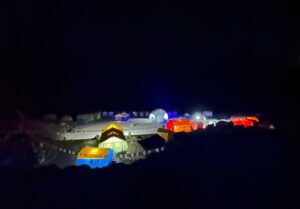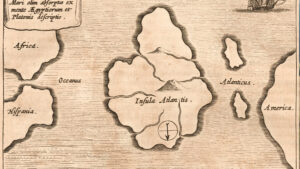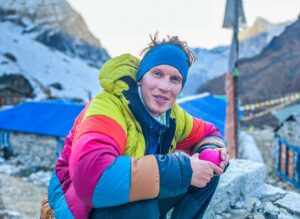Eight years ago today, Muhammad Ali Sadpara, Alex Txikon, and Simone Moro stood on the top of Nanga Parbat. It marked the first winter ascent of the ninth-highest mountain in the world. Five years ago, also on Nanga Parbat, Daniele Nardi and Tom Ballard of the UK disappeared on the dangerous Mummery Spur. They were never seen alive again.
Troubled season
In January 2016, Sadpara and Txikon, along with Adam Bielecki and Jacek Czech of Poland and Daniele Nardi of Italy, began work on the Kinshofer route, according to the AAJ report. Italians Moro and Tamara Lunger were also on the mountain, attempting the Messner-Eisendle-Tomaseth line. However, dangerous conditions prompted them to join the Kinshofer team, who by that time had fixed rope to 6,700m.

Alex Txikon endures the wind at a high camp. Photo: Txikon/Boreal
Although climbers were willing to join forces on the normal route before that final summit push, disagreements and colliding egos were an issue. The Poles quit after Bielecki suffered an ugly 80m fall that he blamed on the Spaniard’s poor-quality rope.
Nardi also had arguments in Base Camp, and when Moro, Txikon, and Lunger agreed to climb together, he felt abandoned. He either had to make a solo attempt or go home. He went home. Bernadette McDonald’s book, Winter 8000, features a detailed account of this.
When a summit window opened, the remaining climbers went up to the top of the fixed ropes, and then continued unroped. No one used oxygen. Lunger retreated 100m from the summit and made it down on her own. Sadpara summited shortly after 3 pm on Feb. 26, 2016. Txikon and Moro quickly followed, in a rather strong wind.

Climbers at Winter Nanga Parbat’s Base Camp: Left to right, Ali Sadpara, Alex Txikon, Simone Moro and Tamara Lunger.
Moro thus became the first climber with four winter firsts on 8,000m peaks. (The others were Shisha Pangma, Makalu, and Gasherbrum II). Meanwhile, Ali Sadpara became the first Pakistani to summit a winter 8,000’er. Unfortunately, Sadpara is not around to celebrate their success. He perished on Winter K2 in 2021.
Nanga Parbat was the 13th 8,000’er to be climbed in winter. Only K2 remained.
Nardi’s obsession
Daniele Nardi attempted Nanga Parbat’s Mummery Spur for the first time in 2013 with Elisabeth Revol of France (see the video below). He then returned for the three following winters, without success. The 2016 attempt, when others summited and he felt shunted aside, was particularly bitter.
In 2019, he was again determined to climb the ominous couloir, which goes up to 6,700m, then continue to the summit.
On each attempt, Nardi had different partners. Only he seemed ready to repeat the Mummery Spur experience. On the 2019 try, his fifth, he teamed up with Tom Ballard. Ballard, a young Briton, was making a name for himself in the European climbing community. The son of UK legend Alison Hargreaves, he had done some impressive climbs of his own. This included soloing the six major North Faces of the Alps in a single winter.

Tom Ballard. Photo: Instagram
Local climbers Karim Hayat and Ramat Ullah Baig joined them for the adventure. But it was hard to stay motivated through weeks of bad weather, which buried higher camps under avalanches. The Pakistanis eventually left, but Ballard and Nardi refused to quit, even as the end of winter approached. Finally, on Feb. 22, 2019, the weather improved. It seemed like the answer to their prayers. But it was a trap.

Tom Ballard (left) and Daniele Nardi. Photo: Daniele Nardi
They reached Camp 2 that day and continued up the following morning. They checked in from Camp 3, but didn’t stop there. Instead, they pitched a fourth camp at 6,000m.
On Feb. 24, they continued, but at around 6,300m, they radioed their cook in Base Camp that they were going to retreat to Camp 4. It was already 7 pm and the weather was bad. That was the last news anyone had from them.
Two days later, the cook and the liaison officer in Base Camp raised the alarm. There was no one else on the mountain, but Karim Hayat and Ullah Baig came back from home to help, and Alex Txikon’s team flew there from K2. In an interview with ExplorersWeb, Txikon recalled the nerve-wracking flight. It included a very tense moment between India and Pakistan at the border.

Daniele Nardi. Photo: Facebook
Txikon’s team scouted the route on foot as high up as the severe avalanche risk allowed. They were among the first teams to use drones at high altitude. Thanks to these, they were able to scout the rest of the Spur. They confirmed that the silhouettes they had seen through a telescope from Base Camp were indeed the lifeless bodies of the two climbers.
They observed that an avalanche had not swept them down. “We could see that the rope above them was tight,” Txikon said. “I can’t tell for sure, but I believe that either they fell, or possibly they were too cold and tired during their descent and they froze when the temperature dropped at sunset.”
Nardi and Ballard were the 84th and 85th victims on Nanga Parbat.
“Nardi was obsessed with Nanga Parbat and he was stubborn,” Txikon told ExplorersWeb. “At the same time, he was no newbie or irresponsible. He knew perfectly well what he was doing. I saw his higher camps: They were neat, perfectly equipped, and ready for a well-planned climb.”






